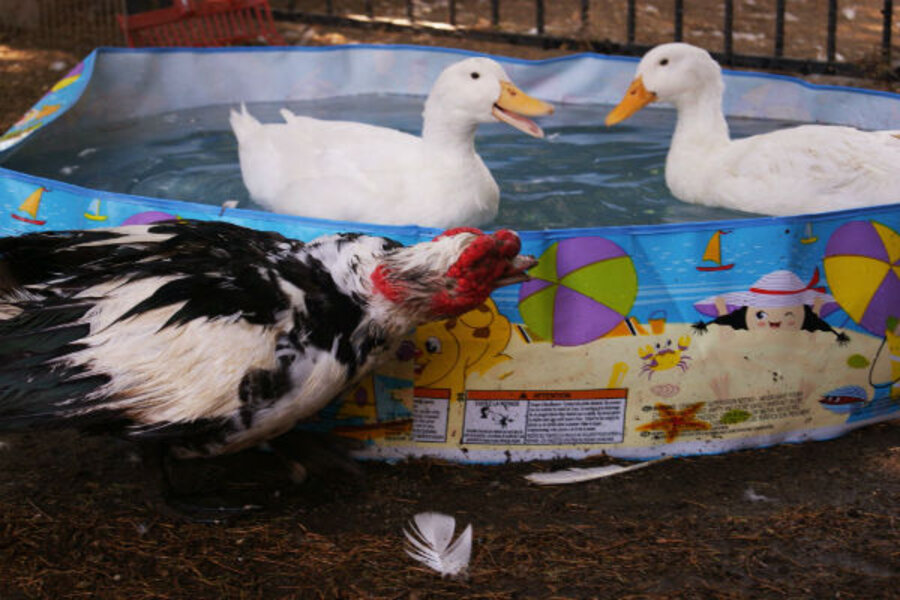Easter bunny horror stories: Resist the urge to give rabbits, ducks, chicks
Loading...
For Easter, when Lindsay Durfee’s sister-in-law Kelley was young and sweet and wide-eyed, her parents bought her a team of ducklings. Kelley and her family, Ms. Durfee says, lived on a lake in Orlando, Fla., populated with different species of wildlife.
So, shouldering a video camera to record it, young Kelley marched her Easter ducklings to the water like a drum major. But nature was ahead of her: before she and the ducks reached the edge of the lake, a large bird – probably a heron– swooped down and made off with a duckling by its neck. The gory detail of what happened next is PG-13; but suffice to say, says Durfee, the videotape captured it and Kelley's scream.
“It's one of those stories that comes up every year,” Durfee wrote in an e-mail to the Monitor. To this day, says Durfee, "My husband and I laugh until we cry over how appalling it is!”
Pet horror stories are a staple of the post-Easter season in the United States, say animal control and rescue officials. The Easter holiday brings out the duckling, chick, and baby bunny lovers in people. They make an impulse buy, the recipient goes wild with joy for a day, but the honeymoon soon ends and parents scramble to surrender the animals.
Animal rescue staff, traditionally inundated with calls from regretful parents following Easter, are asking consumers to stop and think before buying an animal for Easter, and with good reason.
If, and it’s a big if, the animal doesn’t die from all that Easter excitement, now there’s a growing and soon-to-be mature duck, chicken (worse, a rooster), and rabbit on your hands.
A pubescent rabbit is not one to cuddle. Females are prone to running in circles, lunging, and grunting, says Anne Martin, shelter director for House Rabbit Society’s headquarters in Richmond, Calif. And if you purchased a male? “The boys will spray urine ... all over the place,” says Ms. Martin, who owns six rabbits and adds that a mature rabbit is a fantastic pet. But they can be quite alarming for a new pet owner whose supplier did not warn them.
Suppliers are also known for selling bunnies that have been taken away from their mothers too soon, says Mary Cotter, vice president of the House Rabbit Society.
Ducklings and chicks have their own drawbacks, says Susie Coston director of the Farm Sanctuary shelter.
Like bunnies, ducklings and chicks are extremely fragile. If a child plays with them like a toy instead of fine china, they are likely to die from over-handling, Ms. Coston says.
Ducklings for sale tend to be byproducts of the food industry, she says. They can float on water, but that’s where the similarities between ducks in the wild end. They’re heavier than normal ducks and won’t migrate because they can’t fly. They’re more vulnerable to temperature changes and, like young Kelley discovered, easy targets for predators.
Chicks, too, tend to be byproducts of the food industry. If a company needs 15 million hens, they’re hatching 30 million eggs and instead of destroying all the unwanted chicks, the industry finds ways to market them as Easter pets, Ms. Coston says.
Mixed in with the unwanted female chicks are the few male chicks that the industry didn’t automatically destroy. Unsuspecting owners are often surprised when a chick grows into a rooster, and city officials come pecking with a citation for breaking municipal zoning codes.
Ultimately, regretful parents start making phone calls looking for what few animal shelter vacancies there are, and staff start tripping over boxes left on their doorsteps in the middle of the night.
At Farm Sanctuary headquarters in New York, placement coordinator Collin Henstock is the sole person tasked with taking the calls. “It’s just an overwhelming amount,” he says. “After awhile you just know you’re not going to save every animal."
Mr. Henstock says he takes calls from looking to surrender as many as 20 Easter animals from one person.
And that's just people who call to surrender their Easter castoffs. Owners will abandon their Easter animals into the wild, says Coston. She recalls one woman two years ago who called in after discovering a team of ducks walking through her backyard and said: "I'm not sure what happened, but I looked outside and I saw six white ducks." They were the perfect age for Easter ducklings.
Coston also recalls one source bringing in 50 chicks after Easter.
Rabbits are the third most surrendered animal in the country behind cats and dogs, says Martin, who notes that in the San Francisco bay area hear her, 37 stores sell rabbits but only 18 rescue shelters exist to take them in, she says.
While not the case everywhere, calls to select HRS chapters nationwide were met with a voicemail message announcing their shelters were filled to capacity.
What animal rescue and sanctuary staff want to get across to adults is that a large number of these Easter animals, purchased for the fleeting attention of a young child, will end up euthanized at a shelter or set free into the wild to be snatched by a predator.
For animal control and rescue workers it is as traditional as the Easter dinner -- just not as celebrated.
“These are live animals. It isn't funny. It's a sad state of affairs that we see them as almost disposable, like a trinket you have at a holiday,” Coston says. “It's like the goldfish keeps dying but you just get another goldfish.”





